"When is a lie not a lie?" Jeremy Irons' character asks his servant—and lead actress—Ms. Crookshanks (Christie Amery) in "Martial Feats of Comanche Horsemanship." "When it is acting, Master," she responds, repeating a lesson he has obviously taught her before. A lie is not a lie when it is performative, when it is telling a story that everyone understands to be fiction. A lie is not a lie, in other words, when everyone knows it's a lie.
History—as Napoleon supposedly said, and David Milch definitely said—is such a lie agreed upon. It's a constructed narrative, a story we have been told and agreed to believe. Its fragile illusion relies not on fooling us, but on convincing us to be active participants in our own deception. Just as we do when we are watching a play or a movie, we silently agree to suspend our disbelief and accept the obvious artifice as real. Without such willful cooperation from the audience, the performative illusion would shatter. Without such active complicity from all of us, the accepted narratives of our own history would unravel, and the society we have built tenuously upon their foundations would fall. We need the lies—for we are afraid of the truth—and so we are all, to some extent, acting.
Last week, the pilot episode of Watchmen announced, in no certain terms, that the show would be tackling some of the hard truths beneath the tenuous surface of America's sustaining lies. Now, in more workmanlike but still impressive fashion, "Martial Feats of Comanche Horsemanship"—written by Damon Lindelof and Nick Cuse, and directed by Nicole Cassell—takes that mission and brings it down to the microcosmic level of the show's characters. Everyone on Watchmen is acting, after all. The very act of donning a mask to be a superhero is obviously performative—a public-facing lie that everyone understands as a lie—and, in the universe of Watchmen, this lying-as-acting extends to police officers as well. And it does not take much of a stretch of the imagination to realize that the same is true for people who don't wear masks in public, like the late Judd Crawford. (Hell, in the universe of Watchmen, even the President of the United States is an actor, as he was in our own universe when the graphic novel first appeared.)
In "Martial Feats of Comanche Horsemanship," characters begin looking behind the accepted lies of the grand performance, and start uncovering the truths concealed by the costumes. Everyone is playing a role, we realize, whether they are wearing the costume of a superhero, or a police officer, or a terrorist, or a soldier, or a friend.
And if we look closely enough at the nature of the performance—at the insidious purpose of the grand constructed narrative in which we all play our roles—it may occur to us, as the Master says it should, that each of us is also a prop.
"To carry the gun in the service of America is not an honor, but a shame." — German WWI Propaganda
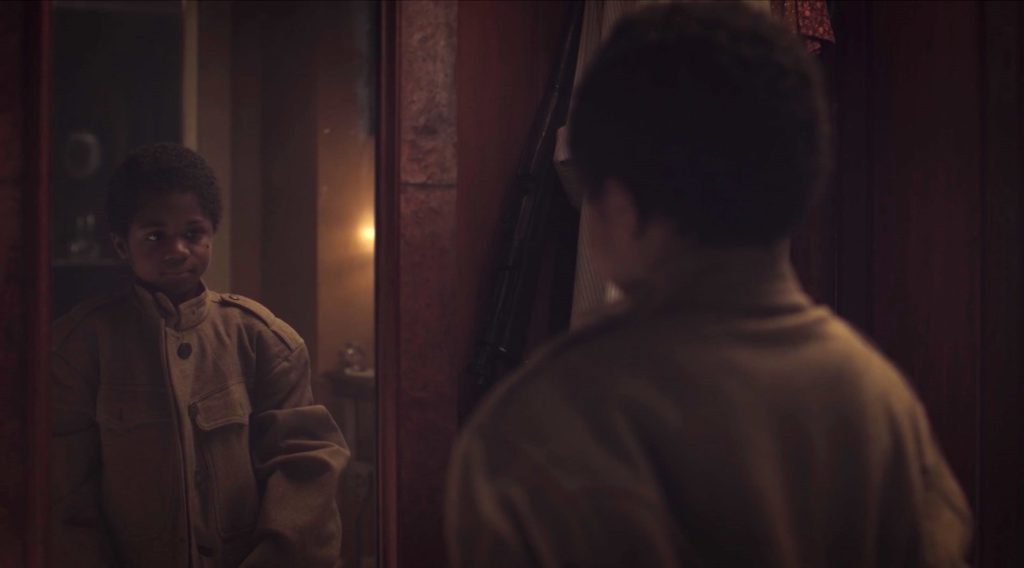
This occurs to young Will in this episode's prologue. We already know that Will believes in heroes—we saw him last week marveling at the onscreen deeds of Deputy Marshal Bass Reeves—and here we see Will trying on the uniform of his father O.B. (Steven G. Norfleet) from the First World War. Bass Reeves was one kind of hero, a lawman. His father—Will no doubt believes—was another kind of hero, a soldier. We imagine Will wondering, as he stares at a movie screen, or stares at his reflection in the mirror, what kind of hero he will be when he grows up.
But Will finds, in the pocket of the uniform, a propaganda letter the Germans dropped on his father's all-black unit.
As I said last week, Watchmen is rich with asides and intertexts, and charges us to follow their threads and interrogate history, to supplement and elucidate the main narrative. The history of black soldiers in the First World War is one of these threads.1 Upon the declaration of war, African-Americans volunteered to serve at such high rates that the War Department stopped accepting black volunteers after one week, having filled their "quotas." Later, when the national draft was enacted, the discriminatory practices were reversed: black soldiers were enlisted at far higher rates than white soldiers, the latter of whom were far more likely to receive exemptions from the all-white draft boards. Originally, the black units were used throughout the theater of war in non-combatant roles, but eventually protest from the African-American community led to the creation of the 92nd and 93rd Divisions, which were all-black combat units.
All told, nearly 400,000 African-Americans served in the First World War, and many of them did so in the hope that putting their country first would help earn respect and secure their rights back home. "The Crisis says, first your Country, then your Rights!," W.E.B. DuBois wrote in 1917. "Certain honest thinkers among us hesitate at that last sentence. They say it is all well to be idealistic, but is it not true that while we have fought our country's battles for one hundred fifty years, we have not gained our rights? No, we have gained them rapidly and effectively by our loyalty in time of trial." Or, as a black soldier on the front told the New York Times, "If we can't fight and die in this war just as bravely as the white men, then we don't deserve equality with white men."
This hope, of course, turned out to be sadly optimistic. Black soldiers who had received grateful cheers from the white citizens of France returned home to find that their status had not changed one whit in the eyes of white Americans; if anything, the situation worsened. "Anti-Black race riots erupted in 26 cities across America in 1919 as portions of White America feared that newly empowered Black men with military training would take liberties and demand change," writes Sean Braswell. "Dozens of Black men were lynched, including several veterans, some in their uniforms." The story had been essentially the same following every war America had ever fought, and would remain the same following every war it would ever fight: black Americans fighting and dying for a country that continues to treat them as second-class citizens.
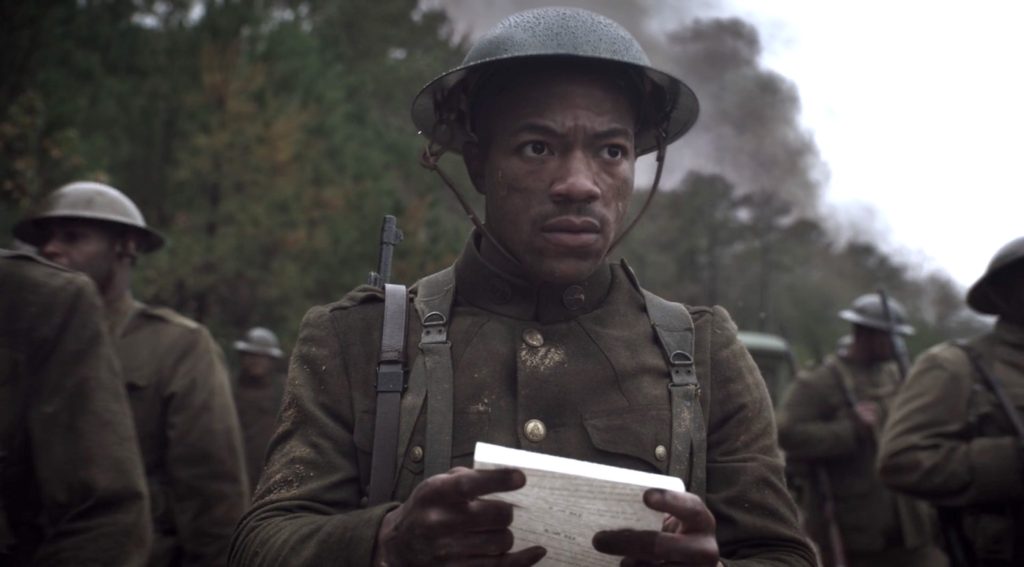
This is the message the German commander sends to the black American soldiers, and he's not wrong. This is the letter O.B. reads as he is literally spat upon by a white cavalry man. The letter is propaganda, but it's also nothing more or less than the truth:
"Hello, boys. What are you doing over here? Fighting the Germans? Have they ever done you any harm? Of course, some white folks and the lying English-American papers told you that the Germans ought to be wiped out for the sake of humanity and democracy. But I ask you boys: What is democracy? Do you enjoy the same rights as the white people do in America? Or aren't you rather treated over there as second-class citizens? Can you get a seat in a theater where white people sit? Or can you even ride in the South in the same streetcar as white people? And how about the law? Is lynching and the most horrible cruelties connected therewith a lawful proceeding in a democratic country?…You have been made the tool of the egotistic rich in America, and there is nothing in the whole game for you but broken bones, horrible wounds, or death. To carry the gun in the service of America is not an honor, but a shame."
This letter obviously resonated enough with O.B. to save it, and carry it with him always. It was the only piece of paper he had on him when its prophecy was once more proven true, during the Tulsa Massacre of 1921, just two years after the soldiers returned home. It was the paper on which he scrawled a desperate note hoping that someone, in the vast, racist landscape of America, would look after his only son.
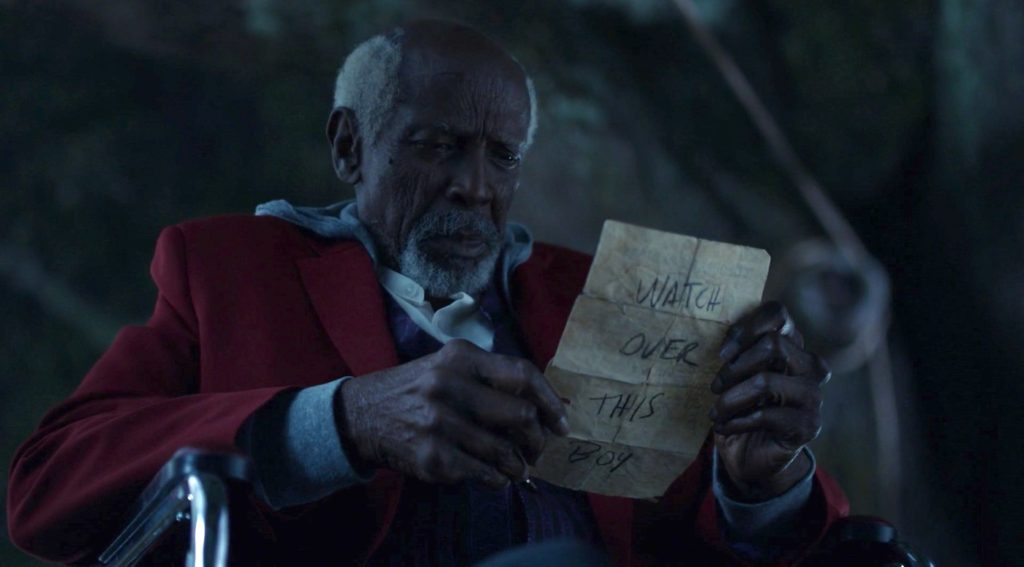
And that son, Will, is still carrying that letter—the plea, lesson, and legacy of his murdered father—nearly a century later, as "Martial Feats of Comanche Horsemanship" opens. He has it out, and rereads its message, as he waits for Detective Angela Abar to join him beneath the swinging body of Police Chief Judd Crawford.
I suggested last week that Angela's arc in Watchmen would be an awakening to the truth of her complicity in a fundamentally unjust system. If we accept the reality that America is, and always has been, a white supremacist state, then to act as an agent of that state—as an enforcer of its existing order—is to be actively complicit in that injustice. To carry the gun in the service of America is not an honor, but a shame, Will's letter says, and there is an uncomfortable accusation there that applies to a police officer as well as to a soldier. Indeed, the distinction is an all but meaningless one for too many communities in America. "Occupied territory is occupied territory, even though it be found in that New World which the Europeans conquered," James Baldwin wrote in 1966, in describing police brutality in Harlem. Very little had changed in Baldwin's Harlem from the days of the Tulsa Massacre of 1921—in which white city officials, police officers, and National Guard members joined forces to destroy Greenwood—and very little has changed in the more than a half century since. (No one who watched the police department's overwhelming, terrifyingly militarized display of force in Ferguson in 2014, for example, should have any confusion about why, in many neighborhoods of America, the police are seen not as protectors of the people but as an occupying army.)

(A defensive side-note: "Stick to the show and leave out the history and politics," I can imagine some of my readers saying. And I do not, for the record, claim to be a particularly sophisticated or enlightened thinker on the subject of race in America: My wrestling with the issues of this show feels, inevitably, clumsy and imperfect. But this is the show: All of this, I am convinced, is what Watchmen is about, and it's such a large and important agenda that I can scarcely believe Lindelof and his diverse writer's room have attempted it. “If we’re going to do a modern retelling [of Watchmen] in 2019, we have to ask, ‘What is it like to be an American right now?'” Lindelof told the Los Angeles Times. “What is the social anxiety? At the time I was asking that question, and even more so today, it felt that the answer was race—a reckoning of the camouflaged history of America.” So I don't even know if it would be possible to discuss this show without discussing all of the historical parallels it evokes and the real-life associations it triggers, but I do know that attempting to do so would be to miss everything that makes this show worth discussing at all. "To not tell a story about race in the context of a political text in 2019 almost felt borderline irresponsible," Lindelof has said, and I think it would be just as irresponsible not to engage with Watchmen primarily on that level.)
"That shit was really easy to find." — Angela
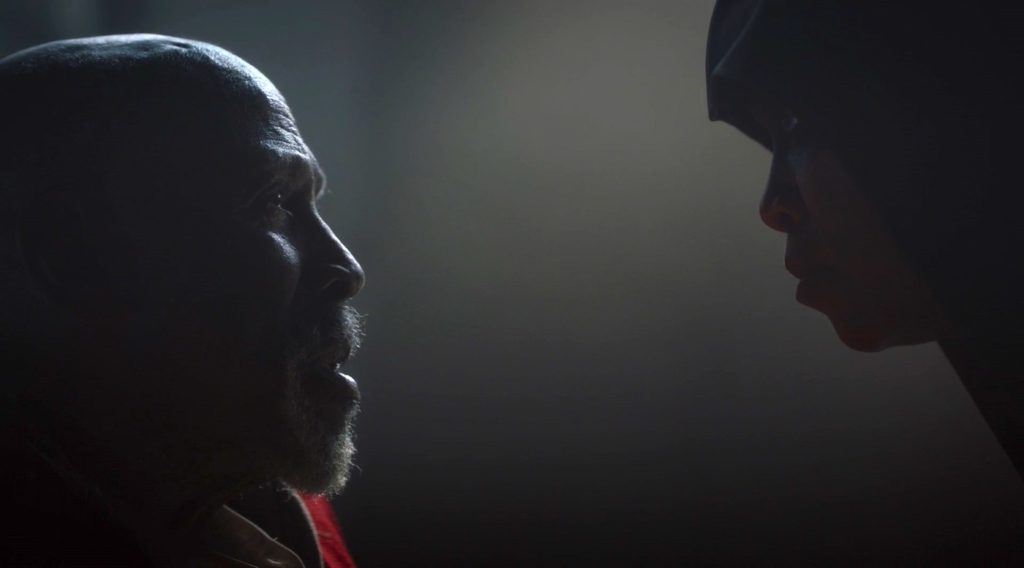
Angela's arc—just in this episode—is a fascinating processing of the truths with which the show is reckoning. Confronted with the murder of her white friend and mentor Judd—and confronted with the black man who claims to have murdered him—Detective Abar does something unusual: She covers it up. Instantly, she removes Will from the scene, and hides him in her bakery. She tells no one about him, and she even pretends to her fellow officers that she never discovered Judd's body at all. It's a curious choice, if we think about it, because on the surface she has no reason to do any of this. She loved Judd, and trusted him. She does not know Will, and she has no reason to trust him. She is a police woman, who has come upon a crime scene, and found someone who is a witness at best, a suspect at worst. Why does she not arrest Will on the spot, and bring him in for interrogation?
We can explain it, certainly, by saying she is behaving like a vigilante superhero, not a cop. (Last episode, after all, we saw her abduct a suspect and keep him in the trunk of her car, without any official sanction from her superiors.) But there are a few other reasons I can think of, and they all speak to the underlying issues that Watchmen is addressing.
First, there is the simple fact that Will is a black man at the scene of a white police officer's murder, and this means his life is absolutely in danger. Angela may be a cop, but she is also a black woman in America, and so she knows she must protect this old black man from the almost certain destruction he seems to be courting. (We do not for a moment imagine that any other detective would have reacted to Will as she does, or that she herself would have behaved the same way if it had been a white member of the Seventh Kavalry she found sitting beneath Judd's body.)
And with this awareness—perhaps not even conscious—comes the next: She cannot trust the system. She knows there is some mystery here—Will may or may not really be guilty of this crime—but she cannot trust her fellow officers, her fellow agents of the state, to look beyond their own anger, prejudices, and interests to find the truth.
All of this the amazing Regina King conveys without a word. And throughout the episode she conveys something else, without every quite articulating it: She must have known, deep down, that there was something off about Judd. I think she must have always known.
This is the only explanation I can find for her actions in "Martial Feats of Comanche Horsemanship." After all, Will tells her virtually nothing: He just repeatedly confesses to stringing up Judd—who, he says, "had skeletons in his closet"—and hints at larger secrets. "There is a vast and insidious conspiracy at play here in Tulsa," he says. "If I told you about it, your head would explode, so I have to give it to you in pieces." "You haven't given me shit," Angela observes, and she's right: He hasn't. But what little he says must resonate with her, tapping into a deep and profound sense of discomfort—of distrust—that she has perhaps been ignoring for a long time.
And it is this subconscious awareness that leads her, later in the episode, to investigate her beloved friend: to invade his privacy, and literally search his closets, while ostensibly paying a condolence call on his widow. "He loved you," Jane Crawford (Frances Fisher) tells Angela. "He really did." But Angela's trust in that love has already been shaken, and perhaps it was never as strong as she herself believed.
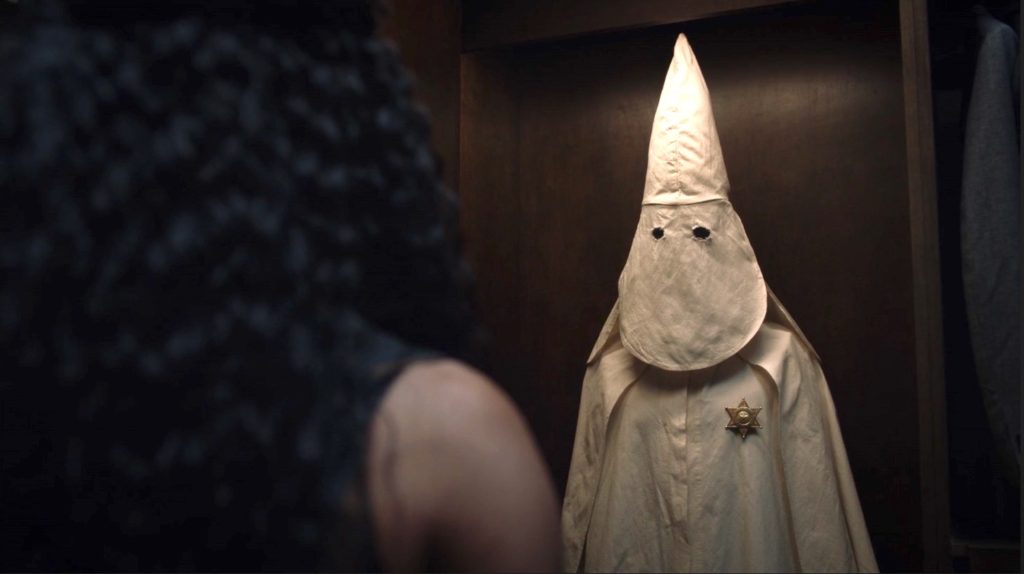
And so she pokes around, and finds perhaps the most disturbing thing she could possibly find. This scene parallels one of the early scenes in the graphic novel Watchmen, where Rorschach—investigating the murder of a man named Edward Blake—opens a hidden closet to discover the costume of the superhero known as The Comedian. Rorschach had worked with The Comedian for years, but never knew his secret identity. Angela has worked with Judd Crawford for years, and the costume she discovers proves that she never knew who he really was. It appears that her friend, her mentor, the head of the police force she serves and a supposed white ally, had been secretly serving the agenda of white supremacy all along.
In the novel, the murder of Edward Blake did, in fact, lead to the discovery of "a vast and insidious conspiracy at play," and Crawford's death will clearly play the same function in the series. But here, we suspect, the conspiracy will be even more vast and insidious, for it is the open conspiracy at the very heart of American history. We get a reminder of that as Angela leaves the house, and the camera lingers on the painting that inspires this episode's title: Comanche Feats of Horsemanship (1834–5), by George Catlin. Catlin was a white colonialist painter who built a career on works documenting Native American tribes during the height of their subjugation and genocide by the U.S. government. Catlin presented himself as a champion of the native people—romanticizing their way of life, and exhibiting empathy for the abuses they were suffering—but he was also himself profiting from the destruction and appropriation of their culture. "Catlin can be seen today as a cultural P.T. Barnum, a crass huckster trading on other people's lives and lifeways," writes W. Richard West, a member of the Cheyenne and Arapaho tribes of Oklahoma and director of the Smithsonian Institution's National Museum of the American Indian. "A native person is challenged, I think, not to feel on some level a profound resentment toward Catlin; his obsession with depicting Indians has an extremely invasive undertone to it. There’s no question . . . he was exploiting Indians and the West as a commodity."
In other words, he was a white man who pretended to be a friend to people of color, but you didn't have to look hard to realize he was just another white man exploiting them. Is this what Judd Crawford was as well, a supposed white ally who really served the cause of white supremacy? As I said when I began, the great lies rely on our willingness to pretend we believe them, and all it takes for the illusions to shatter is our willingness to look beyond them. ("That shit was really easy to find," Angela says, of Judd's Klan robes.) Here, Angela's discovery—and, on some level, her lack of surprise—may resonate with the mistrust many black Americans feel for white Americans who position themselves as allies while benefiting from, and supporting, the existing power structures.
And Angela's dilemma—which will undoubtedly play out in the coming weeks—becomes just a discrete example of the German commander's questions, the questions everyone who carries a gun or badge in the service of the United States should ask: Who am I really working for, and what cause am I really serving?
Angela thinks of herself as someone able to face harsh realities. ("You and I, Topher, we don't do rainbows and lollipops," she tells her adopted son Topher, an orphan of the massacre of police officers known as the White Night. "Because we know those are just pretty colors that hide what the world really is: black and white.") But Angela is not, yet, ready to really ask herself the hard questions. It is interesting to note that it is in the moment she learns that she is Will's granddaughter that she retreats immediately into the comfort of her official role as an agent of the state and tries to arrest him. (We've seen this choice play out in a minor key earlier in the episode, during the raid on Nixonville. Angela initially resists her fellow police officers' desire to express their anger through wanton brutality—especially since she already knows the truth of Judd's death is more complicated—but in the end she surrenders to that instinct and beats a white Nixonville resident nearly to death.) Her dilemma here is a manifestation of the dynamic we hear about many black police officers: how the systemic racism of the force leads them to think of themselves as "blue first, black second." Now—at the moment she learns that she literally carries in her veins the legacy of the racist oppression represented by the Tulsa Massacre—Angela's instinct is to leap back to her hard-fought position within the established power structure. For the moment, at the end of "Martial Feats of Comanche Horsemanship," she rejects that burden, and chooses blue, not black. But we suspect she'll have more and more cause to question that choice as Watchmen proceeds.
"I never felt comfortable in my own skin." — Hooded Justice
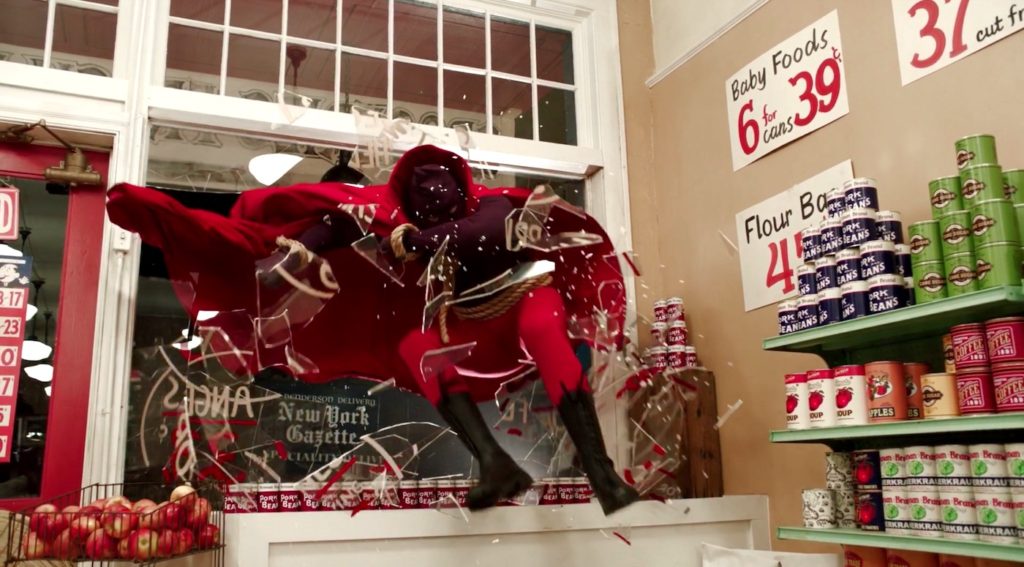
I said last week that this series—like the graphic novel—is rich with intertexts, which comment upon the main narrative in interesting (if not always immediately apparent) ways. "Martial Feats of Comanche Horsemanship" offers us one of those narratives this week, in the televised "American Hero Story" dramatization of the life of the superhero known as Hooded Justice.
In the novel, Hooded Justice—who first appeared in 1938—was America's first costumed vigilante. In his memoir Under the Hood—one of the graphic novel's intertexts, and a book we glimpse on Judd's desk in Episode One—former police officer Hollis Mason recounts how the appearance of Hooded Justice was one of the events that inspired him to put on a silly costume and fight crime. Mason became the second costumed adventurer—the original Nite Owl—and the rest of the superheroes who would form the Minutemen soon followed.
We know little else about Hooded Justice. He is the only member of the Minutemen whose identity is never definitively established. (No one, apparently, ever saw him without his hood.) He was known for being brutally violent, he was alleged to be gay (and in a relationship with another hero, Captain Metropolis), and Mason reports hearing him express admiration for Hitler's Third Reich. Mason recounts how Hooded Justice disappeared after refusing to testify before the House UnAmerican Activities Committee, and how the a German wrestler named Rolf Müller disappeared around the same time. Müller's body washed up in Boston some time later, and Mason speculated—without any proof—that the two men might have been one and the same.
Interestingly, the "American Hero Story" program begins with the recovery of Müller's body, and debunks this theory. "Except that's not me," Hooded Justice narrates. "I just need people to think it is, so they'll stop looking." From there, we flash back to Hooded Justice's debut in 1938, stopping a grocery store robbery, and viciously murdering the robbers in the process.
What does all of this have to do with the main narrative? It seems out of place in the episode, unless we consider an interesting possibility: That Will Reeves was Hooded Justice.
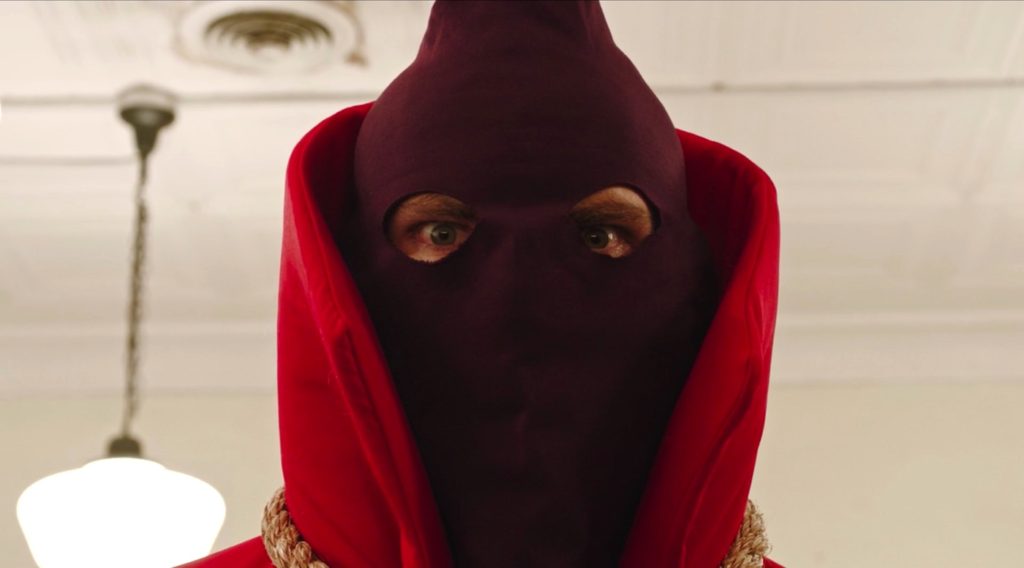
The timing, after all, would be about right: Will—now 105 years old—would have been 24 and in his prime when Hooded Justice made his debut. Will would have been the only black superhero—among some openly racist white colleagues—which would explain why Hooded Justice was never seen without his hood, even by the Minutemen. It might also explain why the hooded costume—as we mentioned last week—evokes both lynching imagery and the image of Marshal Bass Reeves in the silent movie Will was watching when the Tulsa Massacre broke out. (Will has not said his last name yet on the show, but we know from cast lists that he goes by "Will Reeves," having adopted the surname of his hero.)
"When I was little, every time I looked in the mirror, I saw a stranger staring back at me," Hooded Justice narrates, in an episode that begins with young Will staring at his own image—wearing his father's uniform—in the mirror. "He was very, very angry…If he couldn't release his rage, maybe I could help him hide it. I never felt comfortable in my own skin, so I made a new one. And when I slipped it on, he and I became one. His anger became mine, as did his thirst for justice…"
Is this the kind of hero young Will decided to be, choosing to be neither a soldier nor a policeman, but working outside the established systems of alleged justice? In the televised story Hooded Justice is clearly white, but it is a dramatization, and we can't really trust anything in it. (No, not even the narration.) And it is amusing to think of Will painting his eyes white behind his hood, just as Angela now paints hers black behind the cowl of Sister Night.
I do not know for certain if my theory is true, of course, but I think it's true, and I hope it's true. There are no black superheroes in the original graphic novel of Watchmen, but if my theory is correct, Lindelof and his team have seized upon the open mystery of Hooded Justice's identity to rewrite the narrative and establish that it was, ironically, a black man who started it all. Just as Bass Reeves' legend became the whitewashed inspiration for The Lone Ranger, Will Reeves' story became the whitewashed legend of Hooded Justice, and ushered in the entire age of superheroes.
"Nothing ever ends." — Dr. Manhattan
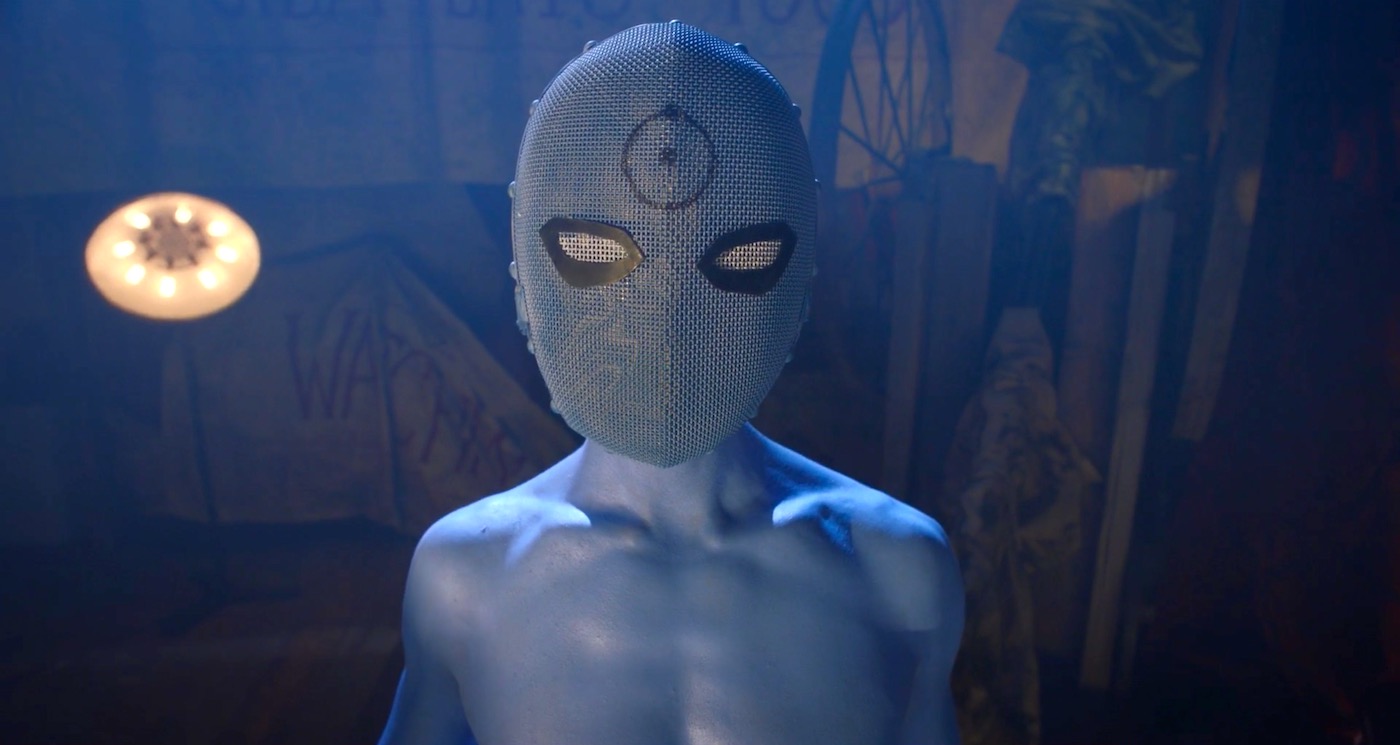
Finally, we have the mystery of just what exactly is going on with Jeremy Irons' character.
I will—as long as I'm throwing my unsubstantiated theories recklessly around—reiterate my prediction from last week that nothing about this is what it appears to be. "Nothing ends, Janey," the stage version of Dr. Manhattan says. "Nothing ever ends." It is a quote not from the scene being enacted, but from Dr. Manhattan's last day on Earth: It was the last thing he said to Adrian Veidt, who had asked him if had done the right thing—in the end.
So yes, it's certainly possible that Irons is playing Adrian Veidt (as IMDB and other sources indicate he is). But to believe that we have to believe that Veidt has nearly perfected the art of cloning (which is certainly possible, for a man who engineered a giant teleporting psychic space-squid), and that he has gone completely insane (which is also possible, for the same reason).
But doesn't it make far more sense if this is Dr. Manhattan himself? Will seeds the idea that we could be fooled this way at the beginning of the episode, suggesting that Dr. Manhattan could look like us now. "He lives on fuckin' Mars, and he can't do that," Angela protests, but Will points out the flaws in her logic. "He can make copies of himself, he can be in two places at the same time, he can grow up to 100 feet tall, change the color of our skin," Will observes. "Why can't he look like us?"
We only glimpsed Dr. Manhattan briefly in the pilot episode, in news footage showing him destroying a large structure he'd constructed out of the sands of Mars.
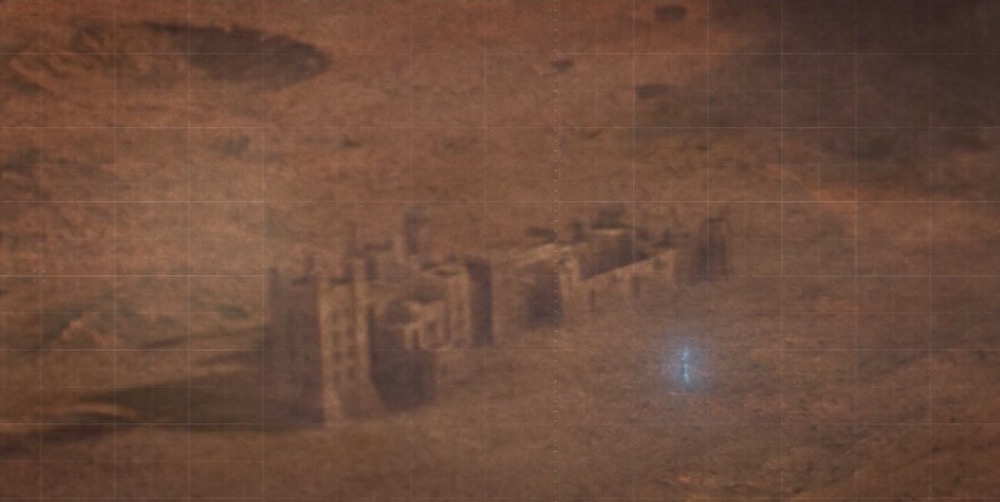
Compare this to the castle in which Irons' character is playing out his curious little tableaux.
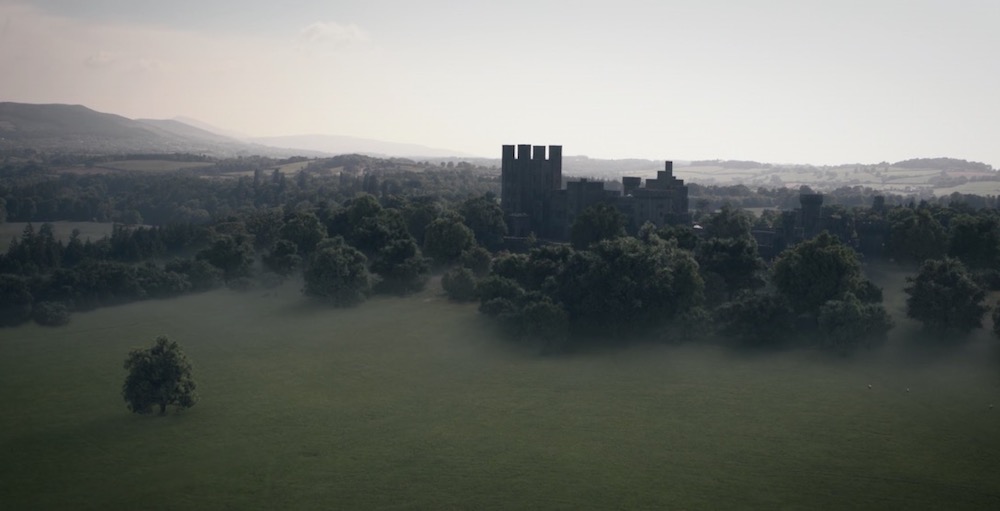
It is—recognizably—more or less the same building, leading us to suspect that Dr. Manhattan has simply upgraded whatever simulation of life he has decided to manufacture on Mars. And the odd-acting, identical humans with whom he has surrounded himself make sense in this context as well. "You'd regained interest in human life," Adrian Veidt said to Manhattan, when they last parted. "Yes, I have," Manhattan said. "I think perhaps I'll create some."
I should say that I'm not actually that interested in puzzling out the mysteries of "puzzle shows." (Lindelof's Lost lost me very quickly.) But Watchmen is making it seem necessary, in order to do what I am interested in doing, which is figuring out what it all means. Like the story of Hooded Justice, the strange, disconnected interludes with Irons' character seem out of place until we question their surface reality and see how they can tie into the larger themes. We need to peek behind their masks to see the truth.
I can't see it yet, but certainly this sequence has more emotional resonance if we read it as a play within a play (within a play). In this manufactured world on Mars, the thing once known as Jon Osterman is retelling his own life story to himself, using imperfect simulacra of human beings as his puppets, as his props. He is rewriting and reexamining his own history. He is attempting to separate the truth from the lies, or perhaps he is attempting to distill—or whitewash, if you will—the complex truth into a more simplistic narrative. (For the story he tells on-stage is a very reductive version of his own origin, and even of his and Janey Slater's characters: It is the received narrative, not the historic truth.) On some level he is attempting, perhaps, to discover how it all went so wrong?
It is an oddly comic sequence, but it is also a disturbingly dark one. He has created human life, and used it to tell his human story, but there is no humanity in them or in himself. (Poor Mr. Phillips realizes his role in the great play too late.) "Real tears!" he admonishes Ms. Crookshanks—in attempting to recreate the last real human moment he ever had—but there is no reality to any of this, just a sad meaningless narrative in a sadly artificial little world.
I don't know what it all means yet. But certainly, as I suggested in the beginning, the play is a fair metaphor for history, for the false and simplistic and dehumanizing fiction in which we all play our roles—and serve as human props—because the truth is larger and more complex and more heartbreaking than we're ready to face.
That's enough to be getting on with for now.
Additional Notes and Favorite Bits
- I didn't have much to say about the White Night sequence, in which Angela is shot by—presumably—a member of the Seventh Cavalry, as part of a coordinated attack on the police force. This was one of the key events that precipitated the world of Watchmen as the series opens—it's why police officers now wear masks—but we don't know enough about it yet to do more than speculate. The most interesting thing about this sequence is the question of what happened to the second gunman, who seemingly had Angela dead to rights. Is it possible Judd—who claimed to be shot in the same attack—was somehow complicit in it? It is possible, even, that he was the second gunman, and spared Angela for as yet unknown reasons? We shall wait and see.
- We also, in this episode, meet Senator Joe Keene (played by James Wolk, Mad Men's Bob Benson). Keene is the son of Senator John Keene, who—in the novel—wrote the eponymous Keene Act that outlawed masked vigilantes.
- I saw references on Twitter to the effect that Topher had superpowers? I didn't read that scene that way. In the novel, Dr. Manhattan's existence led to some technological advances and spin-off products—the shifting fabric of Rorschach's mask was one of these—and I just assumed the levitating "Magna-Hattan Blocks" Topher was playing with were one of these novelty items.
- On the other hand, I have no explanation for why Topher seems to be building the same goddamned building as Dr. Manhattan and Adrian Veidt's castle. Just a visual echo? Hell, maybe this kid is Dr. Manhattan, and in the last episode we'll find out the whole story took place inside his snowglobe. (A reference for older viewers.)
- More things I don't know what to do with: The secretary who takes down the German commander's letter is Fraulein Mueller. Is that just a coincidence, or is she some relation to Rolf Müller? Could that possibly mean anything? (This show has me chasing associative shadows.)
- It was a nice touch to have Professor Henry Louis Gates, Jr. (of Finding Your Roots) play himself—now Secretary of the Treasury—introducing the DNA testing that determines Angela is a descendant of the Tulsa Massacre.
- Jim Beaver is a welcome presence on any show.
- I hope we get much more with Tim Blake Nelson's Looking Glass soon. (And I appreciated his eating food with his mask on, like Rorschach did. I suspect the ways he is, and is not, like Rorschach, will become more significant as the show progresses.)
- More random visual callbacks to the book: the ghost, pirate, and owl costumes Angela's family are wearing echo the trick-or-treating ghost, pirate, and devil who found the body of Nite Owl Hollis Mason on Halloween Night.
- More callbacks: In the novel there was a recurring character of a white newsstand owner who had a running conversation with a young black kid who hung out reading comics all day. He wore a cap, which he eventually gave to the kid, and it looked just like the one worn by the black newsstand owner here (Robert Wisdom). (Both characters died in the attack on New York, so this is not literally that same kid grown up, but that's the suggestion.) And who is the strange little girl (Jolie Hoang-Rappaport) collecting newspapers for?
- In the comics, Mothman was an alcoholic superhero who ended up in a mental hospital after suffering a complete nervous breakdown. Now his tech is apparently being used by paparazzi.
- Wagner's "Ride of the Valkyries" plays during the first appearance of "Dr. Manhattan" in the play. In the first chapter of Under the Hood, Hollis Mason explains how he associates this piece of music with the suicide of a man he knew as a boy. "Every time I hear it I get depressed and start wondering about the lot of humanity and the unfairness of life and all those other things that you think about at three in the morning when your digestion won't let you sleep." The story he tells is really about how he and a bunch of other people laughed at this man's pain right before he killed himself, so it's a parable about inhumanity and indifference. Do with that what you will.
- When Will says he has friends in high places, he really has friends in high places. Is there an Owl Ship up there? (A better one, presumably, than the crappy police knock-offs?) Further proof, perhaps, that Will has some old connections in the cape-and-cowl community.
Notes
- For the information in this section, I am indebted to Sean Braswell’s article “When America Forgot About its Black WWI Soldiers” at Ozy; Jami L. Bryan’s “Fighting for Respect: African-American Soldiers in WWI” at the National Museum of the US Army; and James P. Finley’s “Buffalo Soldiers at Huachuca” in Huachucha Illustrated.
